
This is the first article in a series of three focused on intelligent automation in today’s global business services.
Article 2: Intelligent Automation on the Horizon
Article 3: How Intelligent Automation Will Impact Today’s Global Business Services Model
As multinational companies expanded their operations worldwide, they gradually adopted shared services models to accommodate their global reach. Back-office support services, such as finance & accounting, human resources, and supply chain, are provided neither out of the company’s headquarters nor distributed throughout its business units. Instead, these services are provided through an interlocking network of global service centers. The results have been greater cost savings over traditional country-specific shared services models, greater employee engagement, shorter working capital cycles, and improved vendor relationships. A recent survey undertaken by ScottMadden, in conjunction with the American Productivity & Quality Center (APQC), confirmed that global finance shared services organizations (SSOs) operating in at least ten countries saved more than $35,000 per FTE over those operating in only one country.
At last count, more than 1,000 multinational companies have moved to this model, now commonly referred to as Global Business Services (GBS). While there is no universal approach to designing a multinational global service model, nearly all GBS organizations have common characteristics which help define them. Among these are:
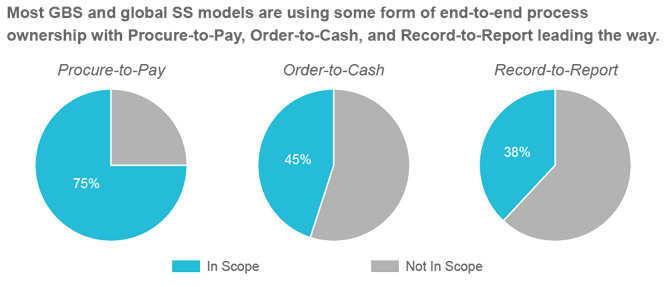
Most GBS organizations are structured to reflect tiered-service management. The most common framework divides work into four categories:
These structures are then used to determine where the work should be performed within the company’s global footprint. Transactional work is generally located within one or more transaction centers located in lower labor cost areas. Functional work, which requires in-depth subject matter expertise, is generally located in service support hubs in closer proximity to the customer. Specialist work is generally centralized in some form of COE, but some may be needed locally to deal with country-specific institutions or requirements. A theoretical GBS framework, using the finance function as an example, is shown in the figure below.
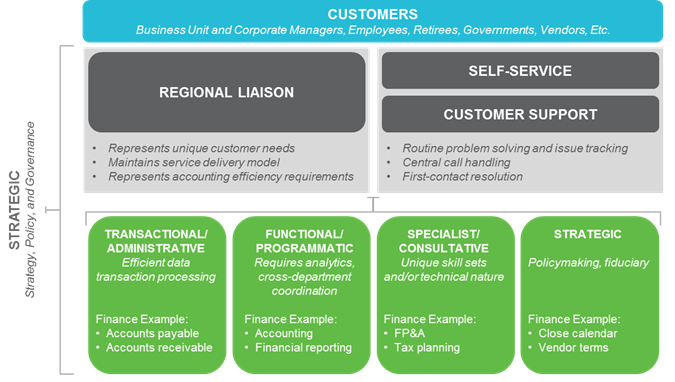
Just how these functions are distributed across the company’s global footprint depends upon the specific functions involved and the nature of the company’s business. A hypothetic GBS organization model is shown in the figure below.
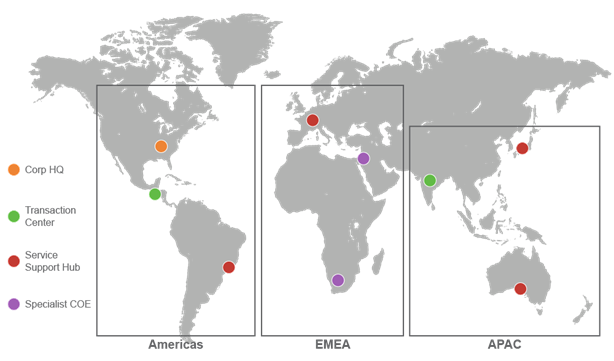
As you might imagine, working out agreements over the design of any GBS global footprint can be daunting. The cost savings and efficiency gains achieved over the past decade testify to those leaders who have struggled to build these worldwide networks.
While we see an increasing number of multinational companies moving to the GBS model, the move has been gradual, and not everyone has jumped on the bandwagon. A recent flash survey of leading SSOs we conducted indicated that only 29% of multinational shared services centers are currently governed globally. Another 23% are managed locally, and the remainder have no shared services organization or global business services or their service delivery is only managed domestically or from one foreign site. (See figure below)
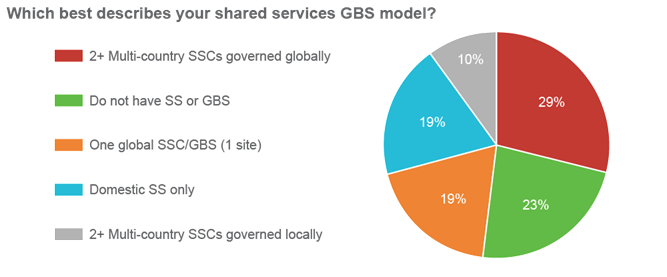
So why, in spite of the benefits achieved by early adopters of service delivery models, are others struggling to move to the GBS model? The answer lies in the nature of the model itself.
Despite these challenges, a growing number of multinational companies continue to move to the GBS model. Similarly, those who have adopted a GBS model continue to add support services under their GBS umbrella. As shown below, human resources leads the way, with finance close behind. Other services, such as IT, facilities, and security, are being added as well.
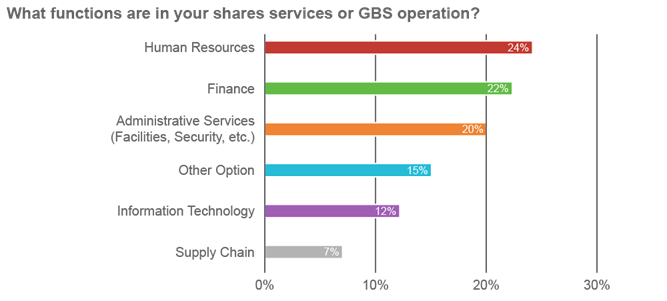
A GBS model is more than just a shared services model—it requires corporations to step outside of normal organizational boundaries to create the most effective model for the enterprise. Unlock the maximum value from your GBS platform by embracing new technologies and avoiding common implementation pitfalls. By doing so, the GBS model can help you realize savings, optimize your service delivery, and quickly adapt to changing global market conditions.
The second article in the series, “Intelligent Automation on the Horizon,” will explore the inevitable rise of intelligent automation and its impact on service delivery. The third article in the series, “How Intelligent Automation Will Impact Today’s GBS Model,” will further explore the quick adoption of intelligent automation technologies to shared services solutions and what that means for GBS organizations.
For more information on how ScottMadden can assist you in designing, implementing, or improving your GBS organization, please contact us.
View MoreSussex Economic Advisors is now part of ScottMadden. We invite you to learn more about our expanded firm. Please use the Contact Us form to request additional information.